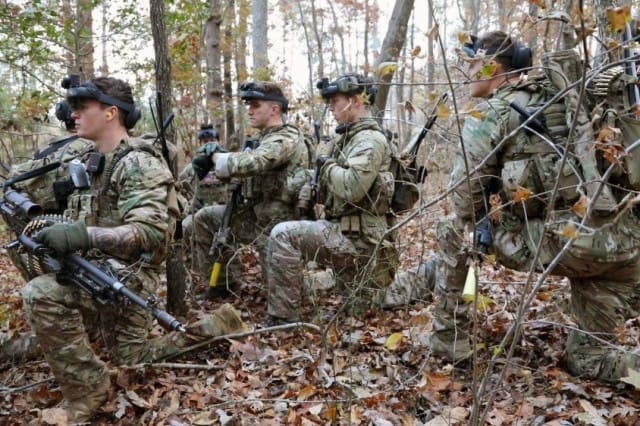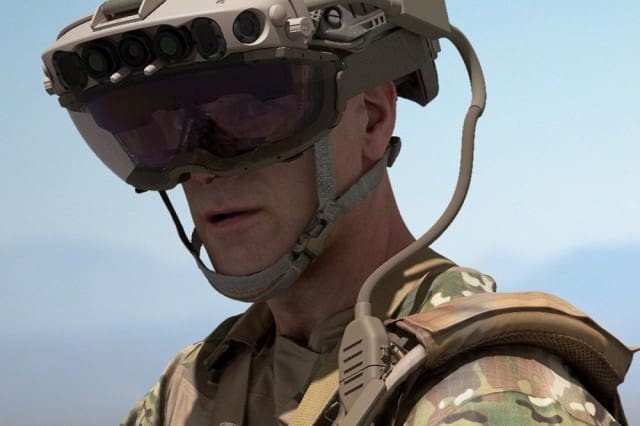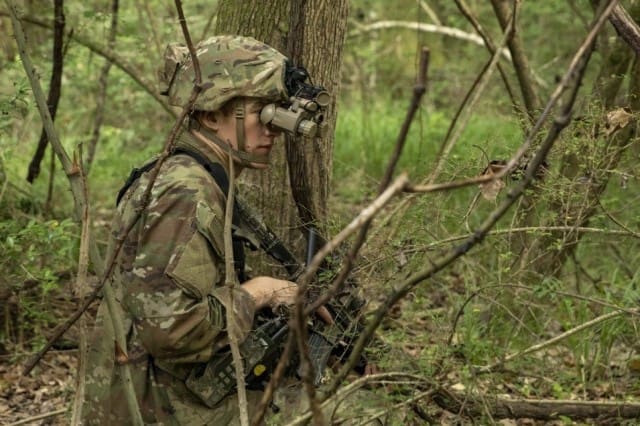
FORT BENNING, Ga. – The Army is on track to equip its Soldiers with state-of-the-art gear that will give them a decisive edge in close-quarters combat, items that include a high-tech goggle, a more lethal rifle, and binoculars that see in the dark, a senior Army leader says in an official video.
The items are among those the Army is working with industry to develop for Soldiers to use on future battlefields in close combat against “near-peer” adversaries, Brig. Gen. David Hodne, the Army’s Chief of Infantry, says in the video.
Hodne also heads the Army’s Soldier Lethality Cross-Functional Team, which is working to develop the three items. Three other officers from the team also appear in the video.
What Hodne calls the “signature modernization efforts” are: the Integrated Visual Augmentation System, known as IVAS; Next Generation Squad Weapons, or NGSW, and the Enhanced Night Vision Goggle-Binocular, or the ENVG-B.
The National Defense Strategy drafted under former Secretary of Defense James Mattis and published in 2018 “identified a worrisome erosion in overmatch between U.S. Forces and our near-peer competitors around the world,” says Hodne.
“Nearly two decades of sustained combat operations continues to yield seasoned leaders and combat veterans skilled in small-unit action,” he says. “However, near-peer competitors studied how we project power, how we fight, and what we fight with.”
Also informing the effort was the “Russian New Generation Warfare Study” that was led by retired Brig. Gen. Pete Jones, a former Chief of Infantry.
“This study,” says Hodne, “combined with the Close Combat Strategic Portfolio Review, and the 2018 National Defense Strategy revealed gaps that warranted serious consideration.”
“Near-peer threats have capabilities that match and in some cases exceed our capabilities,” he says. “In some cases, our adversaries can detect before they’re detected, and that means they can target, and engage, before we do.
“Our current capabilities are not sufficient for battlefields distributed in urban and subterranean environments,” says Hodne. “And we have to anticipate the implications of new technologies on the battlefield and foster a culture of experimentation and calculated risk-taking.”
A major focus of the effort, says Hodne, is the Close Combat Force, or CCF, those who close with and destroy the enemy in close combat.
That force is made up of Soldiers in five military job categories: Infantry, Cavalry scouts, combat engineers, and their accompanying forward observers and medics.
Together they account for 4% of the overall force, Hodne says, and the major percentage of battlefield casualties.
“Historically, 90 percent of battlefield casualties generally occur among four percent of the force,” he says.
“It’s for these specialties, those Soldiers with the purpose of closing with and destroying the enemy in close combat, where we’ve focused our efforts,” he says.
“It’s worth noting this particular cohort of close-combat Soldiers generally receives a small fraction of the budget portfolio intended for modernization,” says Hodne.
Integrated Visual Augmentation System
The first project highlighted in the video is the Integrated Visual Augmentation System, or IVAS. It’s a head-mounted digital goggle that connects to a small computer and a radio. A Soldier can see through it both in daylight and in the dark.
“IVAS takes night vision to a new level with leap-ahead digital technologies,” Lt. Col. Brad Winn says in the video. Winn is the Soldier Lethality CFT’s lead action officer for the IVAS.

“Department of Defense leaders wanted a single device Soldiers could use to fight, rehearse and train,” Winn says. “IVAS is that device. It improves Soldier sensing, decision-making, target acquisition, target engagement and situational awareness.”
According to the video, IVAS can show the Soldier battlefield information about where the enemy is and where others in the Soldier’s unit are; helps Soldiers see a target they need to shoot at, uses facial recognition software that can tell the Soldier who a person is; can translate various languages into English; and allows Soldiers to send one another various kinds of digital information, including map coordinates and imagery of what’s happening on the battlefield.
“IVAS has incorporated Intra-Soldier Wireless Connectivity and the ability to pass data among squad, platoon and company formations,” Winn says. “They can talk to each other and share images on and off the objective.”
That could include, for example, what a certain building or other objective looks like.
“The Soldiers following behind, or the next one on the objective, will know exactly what that objective looks like, whether it’s the inside of a building, wooded terrain – anywhere,” Winn says.
“IVAS enhances every aspect of Soldier lethality,” he says. “It improves and increases the Soldier’s situational awareness and enhances his or her ability to maneuver and outmaneuver our adversaries. IVAS will make a smarter, better-informed, more agile and lethal Soldier. It will save American lives on the battlefield.”
The Army has gathered more than 20,000 hours of testing involving nearly 1,000 Soldiers, Marines, and members of special operations forces, and expects to field the first unit in the latter part of 2021, Winn says.
The Army plans to field it to the entire Close Combat Force in the Army’s 58 brigade combat teams, in the Army’s Active and National Guard components, he says.
Next Generation Squad Weapons
A second item highlighted in the video are Next Generation Squad Weapons, or NGSW.
“Near-peer adversaries continue to acquire and develop capabilities that counter Army squad weapons and ammunition, reducing, and in some cases negating, our combat overmatch,” Maj. Wyatt Ottmar, the Soldier Lethality CFT’s project officer for the NGSW, says in the video.
The NGSW fires a 6.8 mm round. It would replace in the Close Combat Force the M249 and M4A1, both of which fire 5.56 mm rounds, says Ottmar.
Development of the NGSW is an outgrowth of the Army’s 2017 Small Arms Ammunition Configuration Study, which showed the need for a new weapon, Ottmar says.
The Army will test several rifle prototypes produced by various companies and expects to field a new squad weapon in the latter part of 2022.
Enhanced Night Vision Goggle-Binocular
The third project outlined in the video is the Enhanced Night Vision Goggle-Binocular, or ENVG-B.
Night Vision Goggles are far from new, but the ENVG-B gives Soldiers a clearer view and are easier to use, Maj. James Siebert says in the video. Siebert is the Soldier Lethality CFT’s action officer for the ENVG-B project.

“The ENVG-B enables superior combat overmatch by providing Soldiers a binocular system that delivers unparalleled vision day and night in low light, no light, fog, smoke or inclement weather,” says Siebert.
“It offers greater clarity and better depth perception,” he says.
“Rather than looking down at a 2D map or smartphone device, Soldiers see virtual icons overlaid on their real-world view in real time,” says Siebert.
The video was one of several warfighting-related “Warrior Corner” videos produced for viewing by participants in the 2020 Virtual Maneuver Warfighter Conference, held online Sept. 9-10 by Fort Benning’s U.S. Army Maneuver Center of Excellence. The MCoE has since made them available to the public on YouTube.
By Franklin Fisher


Meanwhile the Corps is still issuing LWH helmets from 2003 to their infantry battalions. Can buy one fewer F35B and outfit the entire infantry with new top of the line ballistic helmets and armor.
Even some left over for the bureaucrats to pocket.
1.) Make sure that training is part of that “winning edge”.
2.) USMC acquisition and supply — good luck with your idea, Adam. You’ll still have to turn in your washed long johns, gloves and glove liners, and watch cap to be issued to another person. That’s how close they run their budget.